he narrow inside the Series or
Page 29
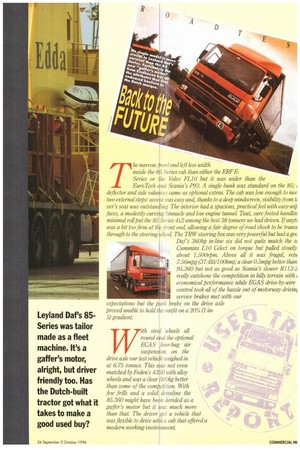
Page 28
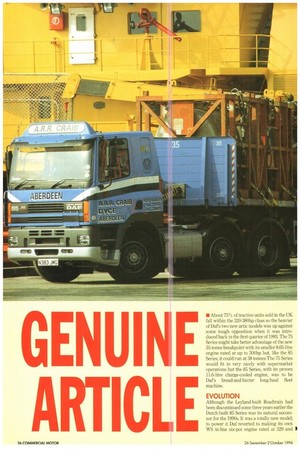
Page 30
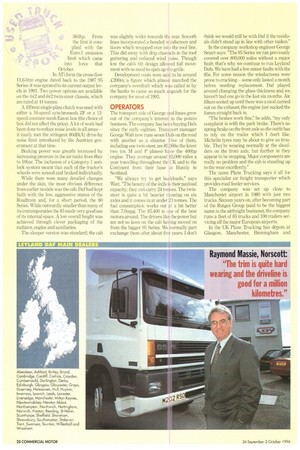
Page 31
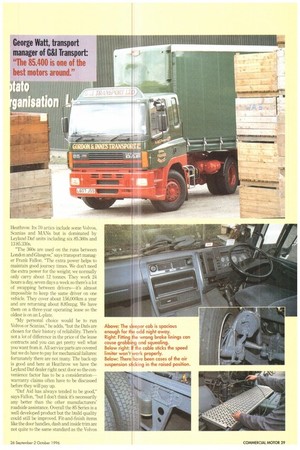
Page 32
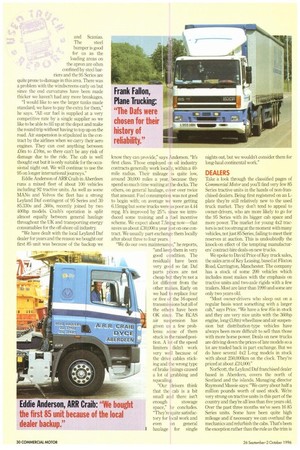
Page 33
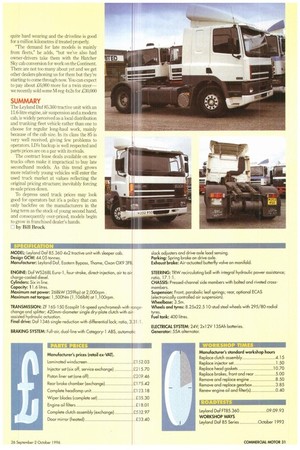
If you've noticed an error in this article please click here to report it so we can fix it.
ont end left less width Series cab than either the ERR Ehe Volvo Fl..10 but it was wider than the
Euro Tech and Scania's P93. A single bunk was standard on the 85; 1 deflector and side valalices came as optional extras. The cab was low enough to nee t two external steps: acc s was easy and, thanks to a deep windscreen, visibility from to ver's seat was outstan mg The interior had a spacious, practical feel with easy-wil faces, a modestly curvi binnacle and low engine tunnel. Taut, sure footed handlin minimal roll put the 85 Series 4x2 among the best 38 tonners we had driven. If anyto was a bit too firm at tl front end, allowing a fair degree of road shock to be trans; through to the steering kvheel The TRW steering box was very powerful but had a goc Daf's 360hp in-line six did not quite match the sl Cummins 1-10 Celect on torque but pulled stoutly about 1,500rprii. Above all it was frugal, retio 756mpg (37.41it/100km); a clear 0.5mpg better than 95.360 but not as good as Scania's slower R113,5 really outshone the competition in hilly terrain with 0 economical Performance while EGAS drive-by-wire control took all of the hassle out of motorway drivin service brakes net with our expectations but proved unable to the park brake on the drive axle hold tw outfit on a 20% (1-in 5) gradient.
Leyland Des 85Series was tailor made as a fleet machine. It's a gaffer's motor, alright, but driver friendly too. Has the Dutch-built tractor got what it takes to make a good used buy?
th stetil wheels all round and the optional ECAS Ifour-bag air suspension on the drive axle our test vehicle weighed in at 6.75 tonnes. This itas not even matched by Fockn's 4350 with alloy wheels and was a clear -00kg better than some of the corn eti Hon. With feu) frills and a solid driveline the \ 85.360 might have be n derided as a \ gaffer's motor but it as much more \ than that. The driver ot a vehicle that
was flexible to drive with a cab that offered a modern working envir nment.
• About 75% of tractive units sold in the UK fall within the 320-380hp class so the heavier of Dafs two new artic models was up against some tough opposition when it was introduced back in the first quarter of 1993. The 75 Series might take better advantage of the new 35-tonne breakpoint with its smaller 8.65-litre engine rated at up to 300hp but, like the 85 Series, it could run at 38 tonnes.The 75 Series would fit in very nicely with supermarket operations but the 85 Series, with its proven 11.6-litre charge-cooled engine, was to be Dafs bread-and-butter long-haul fleet machine.
EVOLUTION
Although the Leyland-built Roadtrain had been discontinued some three years earlier the Dutch-built 85 Series was its natural successor for the 1990s. it was a totally new model; to power it Daf reverted to making its own WS in-line six-pot engine rated at 329 and 364hp. From the first it complied with the Euro-1 emission limit which carne into force that October.
In ATi form the cross-flow 11.6-litre engine dated back to the 1987 95 Series: it was uprated to its current output levels in 1991. Two power options are available on the 4x2 and 6x2 twin-steer chassis, which are rated at 44 tonnes.
A 420mm single-plate clutch was used with either a 16-speed synchromesh ZF or a 12speed constant-mesh Eaton box (the choice of box did not affect the price). A lot of work had been done to reduce noise levels in all areas— it easily met the stringent 80dB(A) drive-by noise limit introduced by the Austrian government at that time.
Braking power was greatly increased by increasing pressure in the air tanks from 8har to 10bar. The inclusion of a Category-I antilock system meant that each of the tractor's wheels were sensed and braked individually.
While there were many detailed changes under the skin, the most obvious difference from earlier models was the cab. Daf had kept faith with the low, aggressive stance of the Roadtrain and, for a short period, the 80 Series. While outwardly smaller than many of its contemporaries the 85 made very good use of its internal space. A low overall height was achieved through clever packaging of the radiator, engine and auxiliaries.
The sleeper version was standard; the cab was slightly wider towards the rear. Smooth lines incorporated a bonded windscreen and doors which wrapped over into the roof line.. This did away with drip channels in the roof guttering and reduced wind noise. Though low the cab's tilt design allowed full movement with no need to open up the grille,
Development costs were said to be around £200m: a figure which almost matched the company's overdraft which was called in by the banks to cause so much anguish for the company for most of 1993.
OPERATORS
The transport side of George tind Innes grew out of the company's interest in the potato business. The company has been buying Dafs since the early eighties. Transport manager George Watt now runs seven Dafs on the road with another as a shunter. Five of them, including one twin-steer, are 85.360s: the latest two (on M and P plates) have the 400hp engine. They average around 83,000 miles a year travelling throughout the UK and to the Continent from their base at liuntly in Scotland.
"We always try to get backloads," says Watt. "The beauty of the 4x2s is their payload capacity: they can carry 24 tonnes. The twinsteer is quite a bit heavier running on six axles and it comes in at under 23 tonnes. The fuel consumption works out at a bit better than 7.0mpg. The 85.400 is one of the best motors around. The drivers like the power but are not so keen on the cab having moved on from the bigger 95 Series. We normally part exchange them after about five years. I don't
think we would still be with Daf if the residuals didn't stand up in line with other makes."
In the company workshop engineer George Smart says: "The 95 Series we ran previously covered over 800,000 miles without a major fault; that's why we continue to run Leyland Dais. We have hada few minor faults with the 85s. For some reason the windscreens were prone to cracking—some only lasted a month before needing replacement. Daf played around changing the glass thickness and we. haven't had one go in the last six months. Air filters sooted up until there was a mod carried Out on the exhaust; the engine just sucked the fumes straight back in.
"The brakes work fine," he adds, "my only complaint is with the park brake. There's no spring brake on the front axle so the outfit has to rely on the trailer which I don't like. Michelin tyres may be about to give us trouble. They're wearing normally at the shoulders on the front axle, but further in they appear to be stepping. Major components are really no problem and the cab is standing up to the wear excellently."
The name Plane Trucking says it all for this specialist air freight transporter which provides road feeder services.
The company was set up close to Manchester airport in 1980 with just two trucks. Sixteen years on, after becoming part of the Rutges Group (said to be the biggest name in the airfreight business), the company runs a fleet of 85 trucks and 100 trailers servicing all the major European airports.
In the UK Plane Trucking has depots at Glasgow. Manchester, Birmingham and
Heathmw. Its 70 artics include some Volvos, Scanias and MANs but is dominated by Leyland Daf units including six 85.360s and 13 85.330s.
"The 360s are used on the runs between London and Glasgow," says transport manager Frank Fallon. "The extra power helps to maintain good journey times. We don't need the extra power for the weight; we normally only carry about 12 tonnes. They work 24 hours a day, seven days a week so there's a lot of swapping between drivers—it's almost impossible to keep the same driver on one vehicle. They cover about 156,000km a year and are returning about 8.85mpg. We have them on a three-year operating lease so the oldest is on an L-plate.
"My personal choice would be to run Volvos or Scanias," he adds, "but the Dafs are chosen for their history of reliability. There's not a lot of difference in the price of the lease contracts and you can get pretty well what you want from it. All service parts are covered but we do have to pay for mechanical failures: fortunately there are not many. The back-up is good and here at Heathrow we have the Leyland Daf dealer right next door so the convenience factor has to be a consideration— warranty claims often have to be discussed before they will pay up.
"Daf Aid has always tended to be good," says Fallon, "but I don't think it's necessarily any better than the other manufacturers' roadside assistance. Overall the 85 Series is a well developed product but the build quality could still be improved. Fit-and-finish items like the door handles, dash and inside trim are not quite to the same standard as the Volvos and Scanias.
The steel bumper is good for us as the loading areas on the apron are often
confined by steel bar riers and the 95 Series are quite prone to damage in this area. There was a problem with the windscreens early on but since the end curvatures have been made thicker we haven't had any more breakages.
"I would like to see the larger tanks made standard; we have to pay the extra for them," he says. "All our fuel is supplied at a very competitive rate by a single supplier so we like to be able to fill up at the depot and make the round trip without having to top up on the road. Air suspension is stipulated in the contract by the airlines when we carry their aero engines. They can cost anything between am to LlOin, so there can't be any risk of damage due to the ride. The cab is well thought out but it is only suitable for the occasional night out. We will continue to use the 95 on longer international journeys."
Eddie Anderson of ARR Craib in Aberdeen runs a mixed fleet of about 100 vehicles including 92 tractive units. As well as some MANs and Volvos the fleet has a strong Leyland Daf contingent of 95 Series and 30 85.330s and .360s, recently joined by two 400hp models. Craib's operation is split almost equally between general haulage throughout the UK and transporting energy consumables for the off-shore oil industry.
"We have dealt with the local Leyland Daf dealer for years and the reason we bought our first 85 unit was because of the backup we
know they can provide," says Anderson, "It's first class. Those employed on oil industry contracts generally work locally, within a 40mile radius. Their mileage is quite low, around 30,000 miles a year, because they spend so much time waiting at the docks. The others, on general haulage, cover over twice that amount. Fuel consumption was not good to begin with: on average we were getting 6.15mpg but some trucks were as pom as 4.44 mpg. It's improved by 25% since we introduced some training and a fuel incentive scheme. We expect about 7.5mpg now—that saves us about .E30,000 a year just on one contract. We usually part-exchange them locally after about three to four years.
"We do our own maintenance," he reports, "and keep them in very good condition, The residuals have been very good so far. Daf parts prices are not cheap but they're not a lot different from the other makes. Early on we had to replace four or five of the 16-speed transmissions but all of the others have been OK since. The ECAS air suspension has given us a few problems: some of them stuck in the raised position. A lot of the speed limiters didn't work very well because of the drive cables sticking and the wrong type of brake linings caused a lot of grabbing and squealing. DYC E
ABERDEE
"Our drivers think that the cab is a bit small and there isn't enough stowage space," he concludes. "They're quite satisfactory for local work and even on general 1 haulage for single nights out, but we wouldn't consider them for long-haul continental work."
DEALERS Take a look through the classified pages of Commenial Motor and you'll find very few 85 Series tractive units in the hands of non-franchised dealers. Being first registered on an Lplate they're still relatively new to the used truck market. They don't tend to appeal to owner-drivers, who are more likely to go for the 95 Series with its bigger cab space and more power. The market for young 4x2 tractors is not too strong at the moment with many vehicles, not just 85 Series, failing to meet their reserves at auction. This is undoubtedly the knock-on effect of the tempting manufacturers' contract-hire deals on new trucks.
We spoke to David Price of Key truck sales, the sales arm of Key Leasing, based at Flixton Road, Carrington, Manchester. The company has a stock of some 200 vehicles which includes most makes with the emphasis on tractive units and two-axle rigids with a few trailers. Most are later than 1.990 and some are only two years old.
"Most owner-drivers who sleep out on a regular basis want something with a larger cab," says Price. "We have a few 85s in stock and they are very nice units with the 360hp engine, long (3.8m) wheelbase and air suspension but distribution-type vehicles have always been more difficult to sell than those with more horse power. Deals on new trucks are driving down the prices of late models so a lot are traded back in part exchange. But we do have several 4x2 L-reg models in stock with about 250,000km on the clock. They're priced at about £24,000."
NorScott, the Leyland Daf franchised dealer based in Aberdeen, covers the north of Scotland and the islands. Managing director Raymond Massie says: "We carry about half a million pounds worth of used stock. We're very strong on tractive units in this part of the country and they're all less than five years old. Over the past three months we've seen 16 85 Series units. Some have been quite high mileage and if necessary we can overhaul the mechanics and refurbish the cabs. That's been the exception rather than the rule as the trim is quite hard wearing and the driveline is good for a million kilometres if treated properly
"The demand for late models is mainly from fleets," he adds, but we've also had owner-drivers take them with the Hatcher Sky cab conversion for work on the Continent. There are not too many about yet and we get other dealers phoning us for them but they're starting to come through now, You can expect to pay about £6,000 more for a twin steer— we recently sold some M-reg 4x2s for ,E30,000
SUMMARY
The Leyland Daf 85.360 tractive unit with an 11.6-litre engine, air suspension and a modern cab, is widely perceived as a local distribution and trunking fleet vehicle rather than one to choose for regular long-haul work, mainly because of the cab size. In its class the 85 is very well received, giving few problems to operators. LD's backup is well respected and parts prices are on a par with its rivals.
The contract lease deals available on new trucks often make it impractical to buy late secondhand models. As this trend grows more relatively young vehicles will enter the used truck market at values reflecting the original pricing structure; inevitably forcing re-sale prices down.
To depress used truck prices may look good for operators but it's a policy that can only backfire on the manufacturers in the long term as the stock of young second hand, and consequently over-priced, models begin to grow in franchised dealer's hands.
O by Bill Brock SPECIFICATION
MODEL Leyland Daf 85.360 4x2 tractive unit with sleeper cab. Design GCW: 44.05 tonnes.
Manufacturer: Leyland Daf, Eastern Bypass, Thome, Oxon 0X9 3FB.
ENGINE: Daf WS268L Euro-1, four-stroke, direct-injection, air to air charge-cooled diesel, Cylinders: Six in line.
Capacity: 11,6 litres.
Maximum net power: 268kW I359hp) at 2,000rpm Maximum net torque: 1,500Nm (1,10611aft) at 1,100rpm, TRANSMISSION: ZF 16S-150 Ecosplit 16-speed synchromesh with rangechange and splitter; 420mm-diameter single dry-plate clutch with air assisted hydraulic actuation. Final drive: Dal 1346 single-reduction with differential lock; ratio, 3,31 1
BRAKING SYSTEM: Full-air, dual-line with Category-1 ABS, automatic Generator: 55A alternator.
slack adjusters and drive-axle load sensing. Parking: Spring brake on drive axle. Exhaust brake: Air-actuated butterfly valve on manifold.
STEERING: TRW recirculating ball with integral hydraulic power assistance; ratio, 17.1:1. CHASSIS: Pressed-channel side members with bolted and riveted crossmembers.
Suspension: Front, parabolic leaf springs; rear, optional ECAS (electronically controlled air suspension).
Wheelbase: 3.5m.
Wheels and lyres: 8.25x22.5 10-stud steel wheels with 295/80 radial tyres. Fuel tank: 400 litres, ELECTRICAL SYSTEM: 24V; 2x1 2V 135Ah batteries.
WORKSHOP TIMES 1=1•11
Manufacturer's standard workshop hours Replace clutch assembly 4.15 Replace injector set 1.50 Replace head gaskets 10.70 Replace brakes, front and rear 5.00 Remove and replace engine 8.50 Remove and replace gearbox 3.85 Renew engine oil and filter-(s) 0.40
°ARTISTS
Leyland Dal FT85.360 09.09.93 WORKSHOP WAYS Leyland Daf 85 Series October 1993








































































































































